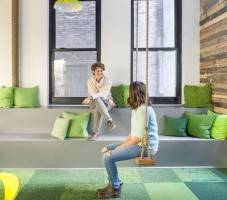 Research presented at the recent 2015 Global Wellness Summit (GWS) titled “The Future of Wellness at Work” forecasts that workplace wellness investment will “explode in the next 5 to 10 years”. Results from the research revealed that 87 percent of employees surveyed feel disengaged at work, with 38 percent experiencing excessive pressure and stress. Despite more than half of the employees having access to a structured wellness “programme” only three out of ten actually use it in practice. The generally human resources led workplace wellness programs perform poorly because they don’t always address the issue at hand. They instead choose to focus on health issues experienced outside of work, rather than looking internally at the workplace itself. The design of an office has been proven to have a material impact on the health, wellbeing and productivity of its inhabitants.
Research presented at the recent 2015 Global Wellness Summit (GWS) titled “The Future of Wellness at Work” forecasts that workplace wellness investment will “explode in the next 5 to 10 years”. Results from the research revealed that 87 percent of employees surveyed feel disengaged at work, with 38 percent experiencing excessive pressure and stress. Despite more than half of the employees having access to a structured wellness “programme” only three out of ten actually use it in practice. The generally human resources led workplace wellness programs perform poorly because they don’t always address the issue at hand. They instead choose to focus on health issues experienced outside of work, rather than looking internally at the workplace itself. The design of an office has been proven to have a material impact on the health, wellbeing and productivity of its inhabitants.
The positive workplace is a culture built from the following three elements. The research suggests that workplace wellness approaches will evolve beyond these traditional “programs” to instead embrace a fully integrated positive workplace culture. One key aspect of this initiative will be a holistic approach to healthy workplace design, made up of three elements: space, environment and health.
Dynamic Space Planning
The modern office will increasingly promote mobility with difference spaces for concentration, interaction, debate, reflection and all manner of other business use cases depending on the business sector. The placement of the desk thus becomes a secondary consideration. It is no longer the focus on where the work has traditionally taken place, instead this approach challenges the status quo on the possibilities of where work could take place.
When designing with a ‘positive workplace’ culture in mind, desk density has become a key consideration. A British Council for Offices study found that the average mean density is one workplace per 10.9 Square Metres net internal area (NIA). They go on to suggest that densities have risen over recent years with “economic pressures and technology enablement” combining to encourage changes in working styles. However, densities can only increase so far and are levelling out. You can decrease the density if your working model allows for collaboration in multiple spaces, using dynamic space planning, rather than relying on the majority of employees being just desk-based.
Environmental Design Practices
The recent GWS research also suggests companies will also begin to measure success not by return on investment, but by the total return on value. This includes measuring the extent of their duty of care and environmental accreditations for the benefit of their business and their employees. Therefore sustainable design practices will tie into everything that goes in to achieving a modern and efficient workplace. From lighting surveys to sustainable products, it all counts.
The contemporary living wall is an example of an office design feature encompassing the principles mentioned above. Aside from the obvious aesthetic and air quality benefits, the RHS cite that green walls provide an extra layer of insultation, cutting down on energy loss and decreasing heating and cooling requirements and contribute to reduced noise pollution.
Active Approach to Employee Health
Employee sickness days are costing a staggering £29 Billion each year in the UK alone and runs into the trillions in the US. Surely a better approach would be to integrate actively managing health, not sickness, into the positive workplace culture?
Considering the average person checks their phone over 100 times a day, encouraging employees to unplug from the ‘always on’ work culture would be a step in the right direction. Managing our use of technology is just one aspect of a healthier workplace, the GWS research also proposed better balance of work-life management through initiatives such as unlimited vacations and truly flexible working hours.
The Net Result of A ‘Positive Workplace’ Culture
Taking a more holistic approach to workplace design firmly incorporates wellbeing and productivity into form and function. A positive workplace culture will result in higher levels of productivity, engagement and staff retention and lower levels of absenteeism, compared to the results produced from the traditional workplace wellness “program”. For workplaces to adapt they need to radically redesign their working practices and environment to suit today’s modern worker.
To find out more about the GWS findings see their Round Table Report.
______________________________
 Scott Colman, Creative Director of Blue Jelly. Creative and practical, Scott is responsible for what colleagues refer to as the ‘fluffier’ side of the business. https://bluejelly.net/
Scott Colman, Creative Director of Blue Jelly. Creative and practical, Scott is responsible for what colleagues refer to as the ‘fluffier’ side of the business. https://bluejelly.net/














December 21, 2015
From workplace wellness programmes to a positive workplace culture 0
by Mark Eltringham • Comment, Wellbeing, Workplace, Workplace design
The positive workplace is a culture built from the following three elements. The research suggests that workplace wellness approaches will evolve beyond these traditional “programs” to instead embrace a fully integrated positive workplace culture. One key aspect of this initiative will be a holistic approach to healthy workplace design, made up of three elements: space, environment and health.
Dynamic Space Planning
The modern office will increasingly promote mobility with difference spaces for concentration, interaction, debate, reflection and all manner of other business use cases depending on the business sector. The placement of the desk thus becomes a secondary consideration. It is no longer the focus on where the work has traditionally taken place, instead this approach challenges the status quo on the possibilities of where work could take place.
When designing with a ‘positive workplace’ culture in mind, desk density has become a key consideration. A British Council for Offices study found that the average mean density is one workplace per 10.9 Square Metres net internal area (NIA). They go on to suggest that densities have risen over recent years with “economic pressures and technology enablement” combining to encourage changes in working styles. However, densities can only increase so far and are levelling out. You can decrease the density if your working model allows for collaboration in multiple spaces, using dynamic space planning, rather than relying on the majority of employees being just desk-based.
Environmental Design Practices
The recent GWS research also suggests companies will also begin to measure success not by return on investment, but by the total return on value. This includes measuring the extent of their duty of care and environmental accreditations for the benefit of their business and their employees. Therefore sustainable design practices will tie into everything that goes in to achieving a modern and efficient workplace. From lighting surveys to sustainable products, it all counts.
The contemporary living wall is an example of an office design feature encompassing the principles mentioned above. Aside from the obvious aesthetic and air quality benefits, the RHS cite that green walls provide an extra layer of insultation, cutting down on energy loss and decreasing heating and cooling requirements and contribute to reduced noise pollution.
Active Approach to Employee Health
Employee sickness days are costing a staggering £29 Billion each year in the UK alone and runs into the trillions in the US. Surely a better approach would be to integrate actively managing health, not sickness, into the positive workplace culture?
Considering the average person checks their phone over 100 times a day, encouraging employees to unplug from the ‘always on’ work culture would be a step in the right direction. Managing our use of technology is just one aspect of a healthier workplace, the GWS research also proposed better balance of work-life management through initiatives such as unlimited vacations and truly flexible working hours.
The Net Result of A ‘Positive Workplace’ Culture
Taking a more holistic approach to workplace design firmly incorporates wellbeing and productivity into form and function. A positive workplace culture will result in higher levels of productivity, engagement and staff retention and lower levels of absenteeism, compared to the results produced from the traditional workplace wellness “program”. For workplaces to adapt they need to radically redesign their working practices and environment to suit today’s modern worker.
To find out more about the GWS findings see their Round Table Report.
______________________________